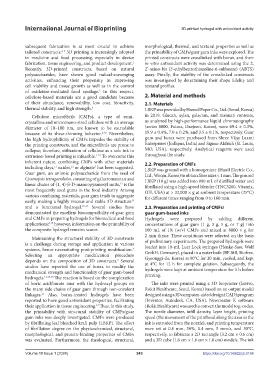Page 251 - IJB-10-1
P. 251
International Journal of Bioprinting 3D-printed hydrogel with antioxidant activity
subsequent fabrication is at most crucial to achieve morphological, thermal, and textural properties as well as
tailored constructs. 3D printing is increasingly adopted the printability of CMFs/guar gum inks were explored. The
2-5
in medicine and food processing, especially in device printed constructs were crosslinked with borax, and their
fabrication, tissue engineering, and product development. in vitro antioxidant activity was determined using the 2,
1
Recently, 3D-printed constructs, based on natural 2’-azino-bis (3-ethylbenzothiazoline-6-sulfonate) (ABTS)
polysaccharides, have shown good radical-scavenging assay. Finally, the stability of the crosslinked constructs
activities, enhancing their propensity in improving was investigated by determining their shape fidelity and
cell viability and tissue growth as well as in the control textural profiles.
of oxidation-mediated food spoilage. In this respect,
3
cellulose-based materials are a good candidate because 2. Material and methods
of their abundance, renewability, low cost, bioactivity, 2.1. Materials
thermal stability, and high strength. 6 LBKP was provided by Hansol Paper Co., Ltd. (Seoul, Korea)
Cellulose microfibrils (CMFs), a type of semi- in 2019. Glucan, xylan, galactan, and mannan contents,
crystalline and micro/nano-sized cellulose with an average as analyzed by high-performance liquid chromatography
diameter of 10–100 nm, are known to be extrudable (series 6000, Futecs, Daejeon, Korea), were 69.4 ± 0.3%,
because of its shear-thinning behavior. 2,3,6 Nevertheless, 19.9 ± 0.4%, 7.0 ± 0.2%, and 3.5 ± 0.1%, respectively. Guar
the high hydrophilicity of CMFs impedes the stability of gum and borax were purchased from Shree Vijay Laxmi
the printing constructs, and the microfibrils are prone to Enterprises (Jodhpur, India) and Sigma-Aldrich (St. Louis,
collapse; therefore, utilization of cellulose as a sole ink in MO, USA), respectively. Analytical reagents were used
extrusion-based printing is infeasible. 7-10 To overcome this throughout the study.
inherent nature, combining CMFs with other materials 2.2. Preparation of CMFs
including clays, oxides, or alginate has been suggested. LBKP was ground with a homogenizer (Hanil Electric Co.,
7
11
12
Guar gum, an anionic polysaccharide from the seed of Ltd., Wonju, Korea) to obtain fiber sizes < 1 mm. The ground
Cyamopsis tetragonoloba, consisting of galactomannan and LBKP (10 g) was added into 990 mL of distilled water and
linear chains of (1, 4)-β-D-mannopyranosyl units, is the fibrillated using a high-speed blender (TNC5200, Vitamix,
13
most frequently used gums in the food industry. Among OH, USA) at > 32,000 × g at ambient temperature (25°C)
various combining materials, guar gum tends to aggregate for different times ranging from 0 to 160 min.
easily, making a highly viscous and stable 3D structure
14
and a functional hydrogel. 15-17 Several studies have 2.3. Preparation and printing of CMFs/
demonstrated the excellent biocompatibility of guar gum guar gum-based inks
and CMFs in preparing hydrogels for biomedical and food Hydrogels were prepared by adding different
applications; however, information on the printability of concentrations of guar gum (1 g, 3 g, 5 g, or 7 g) into
5,18
the composite hydrogel remains scarce. 100 mL of 1% (w/v) CMFs and mixed at 8000 × g for
2 min thrice. These conditions were selected on the basis
Maintaining the structural stability of 3D constructs
is a challenge during storage and application in various of preliminary experiments. The prepared hydrogels were
loaded into 10-mL Luer Lock syringes (Henke-Sass, Wolf
systems, hence necessitating post-printing modification. GmbH, Germany), placed in a water bath (BF-StB, Biofree,
4
Selecting an appropriate modification procedure Gyeonggi-do, Korea) at 90°C for 20 min, cooled, and kept
depends on the composition of 3D constructs. Several at 4°C for 12 h for complete gelation. Subsequently, the
2
studies have reported the use of borax to modify the hydrogels were kept at ambient temperature for 1 h before
mechanical strength and functionality of guar gum-based printing.
hydrogels. 13,17,18 The reaction is based on the complexation
of boric acid/borate ions with the hydroxyl groups on The inks were printed using a 3D bioprinter (Invivo,
the many side chains of guar gum through non-covalent Rokit Healthcare, Seoul, Korea) based on an output model
linkages. Also, borax-treated hydrogels have been designed using a 3D computer-aided design (CAD) program
13
reported to have good antioxidant properties, facilitating (Inventor, Autodesk, CA, USA). Newcreator K software
their application in tissue engineering. Thus, in this study, (Rokit Healthcare) was used to convert the model to g-codes.
13
the printability with structural stability of CMFs/guar The nozzle diameter, infill density, layer height, printing
gum inks was deeply investigated. CMFs were produced speed (the movement of the printhead along the axes as the
by fibrillating leaf bleached kraft pulp (LBKP). The effect ink is extruded from the nozzle), and printing temperature
of fibrillation degree on the physicochemical, structural, were set at 0.8 mm, 50%, 0.4 mm, 5 mm/s, and 30°C,
morphological, and protein-binding properties of CMFs respectively, to fabricate a 2D rectangle (3.2 cm × 0.6 cm)
was evaluated. Furthermore, the rheological, structural, and a 3D cube (1.6 cm × 1.6 cm × 1.0 cm) models. The ink
Volume 10 Issue 1 (2024) 243 https://doi.org/10.36922/ijb.0164

